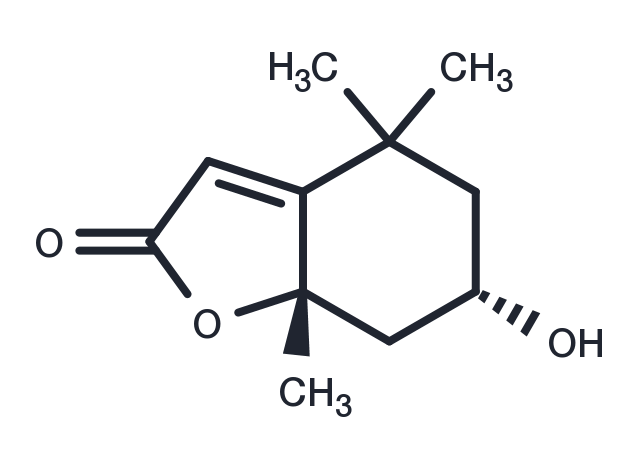Powder: -20°C for 3 years | In solvent: -80°C for 1 year


Isololiolide has phytotoxicity, it inhibited seedling growth of cress and barnyard grass. It also showed in vitro activity against both trypomastigote and intracellular amastigotes of Trypanosoma cruzi, with IC50 values of 32 μM and 40 μM, respectively. Isololiolide is an antioxidant response element (ARE) inducer, it has anti-inflammatory activity. It can exert a selective cytotoxic activity on hepatocarcinoma HepG2 cells as well as induce apoptosis through the modulation of apoptosis-related proteins.

| Pack Size | Availability | Price/USD | Quantity |
|---|---|---|---|
| 5 mg | Inquiry | $ 860.00 | |
| 1 mL * 10 mM (in DMSO) | Inquiry | $ 870.00 |
| Description | Isololiolide has phytotoxicity, it inhibited seedling growth of cress and barnyard grass. It also showed in vitro activity against both trypomastigote and intracellular amastigotes of Trypanosoma cruzi, with IC50 values of 32 μM and 40 μM, respectively. Isololiolide is an antioxidant response element (ARE) inducer, it has anti-inflammatory activity. It can exert a selective cytotoxic activity on hepatocarcinoma HepG2 cells as well as induce apoptosis through the modulation of apoptosis-related proteins. |
| In vitro | Organic agriculture emphasized using of biologically originated herbicides and phytotoxic substances are being considered as a replacement to chemical herbicides. Marsilea crenata is an aquatic perennial fern distributed in the South-East Asian countries and is well known for various biological properties. However, to date, there has been no report that addresses the phytotoxicity of Marsilea crenata. METHODS AND RESULTS: Therefore, we explored phytotoxic properties and phytotoxic substances from Marsilea crenata. An aqueous methanol extracts of Marsilea crenata showed inhibition on the seedling growth of cress, lettuce, alfalfa, barnyard grass, Italian ryegrass, and foxtail fescue. Inhibition increased with increasing extract concentration. The extract was purified by several chromatographic steps and two phytotoxic substances were isolated and identified by spectroscopic analysis as loliolide and Isololiolide. At the concentration of 30 μM, loliolide and Isololiolide inhibited seedling growth of cress and barnyard grass by 41.3 to 51.1%, and 58.15 to 87.5% of control seedlings, respectively. The concentrations required for 50% inhibition of cress and barnyard grass seedlings ranged from 32.1 to 128.5 μM for loliolide, 37.0 to 176.2 μM for Isololiolide. CONCLUSIONS: These results suggest these compounds may be responsible for phytotoxic effects of Marsilea crenata extract and could be an important part of organic agriculture. |
| Source |
| Molecular Weight | 196.24 |
| Formula | C11H16O3 |
| CAS No. | 38274-00-9 |
Powder: -20°C for 3 years | In solvent: -80°C for 1 year
You can also refer to dose conversion for different animals. More
bottom
Please see Inhibitor Handling Instructions for more frequently ask questions. Topics include: how to prepare stock solutions, how to store products, and cautions on cell-based assays & animal experiments, etc.
Isololiolide 38274-00-9 inhibitor inhibit
